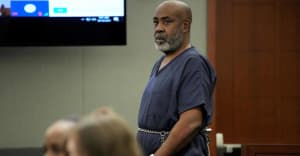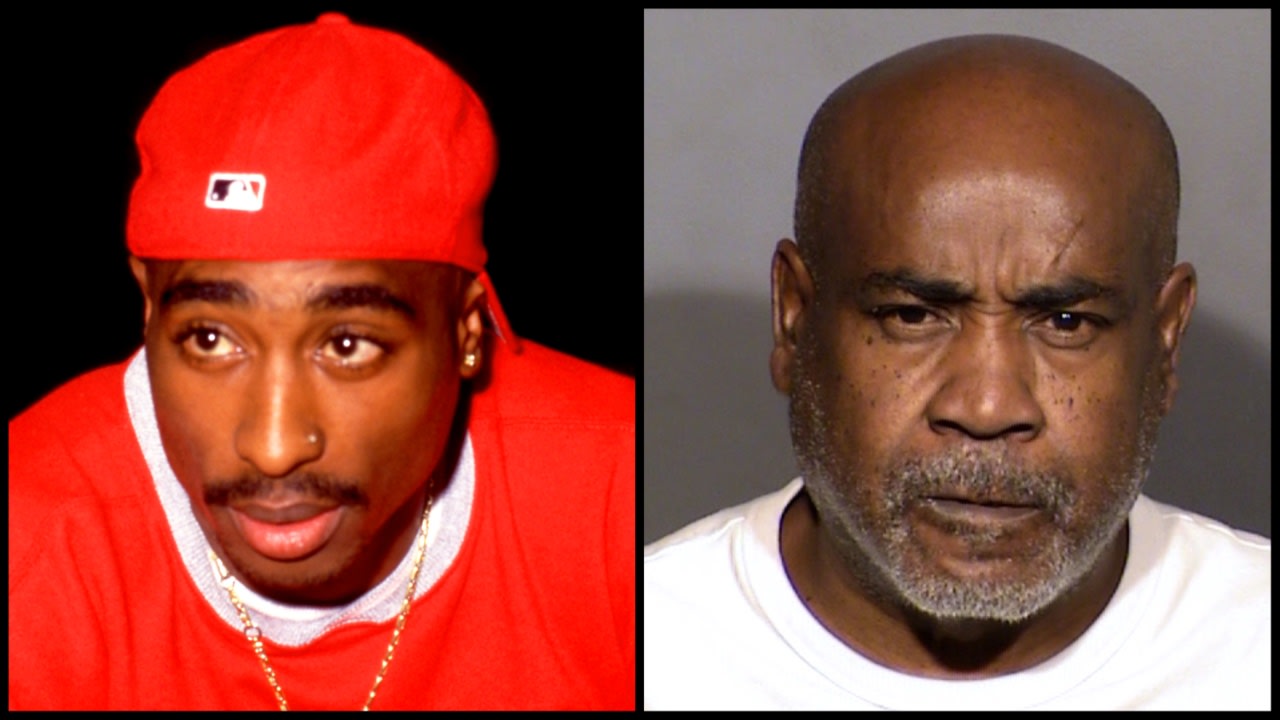 Left: Tupac Shakur, photo by Bob Berg/Getty Images. Right: Duane Keith “Keefe D” Davis, photo by Las Vegas Metropolitan Police Department via Getty Images.
Left: Tupac Shakur, photo by Bob Berg/Getty Images. Right: Duane Keith “Keefe D” Davis, photo by Las Vegas Metropolitan Police Department via Getty Images.
Tupac Shakur’s unsolved murder is one of history’s highest-profile cold cases. Despite the mountains of evidence uncovered by independent investigations, the Las Vegas Metropolitan Police Department failed to make a single arrest directly related to the case for 27 years. Until very recently, it seemed as though the people responsible for Tupac’s death would never be tried in a court of law. But on Friday, September 29, Duane Keith “Keefe D” Davis — a man whose name is infamous among those who’ve followed the case through the years — was arrested and charged with murder.
In a press conference, LVMPD Homicide Lieutenant Jason Johansson said the department does not believe Davis was the person who fatally shot Tupac on September 7, 1996, but he described Davis as the “shot caller” of the plan to kill Shakur, claiming he passed the murder weapon to the shooter immediately before the shooting took place.
Davis’s involvement in Tupac’s demise is not a surprise to anyone who’s updated their knowledge of the case in the past decade. It’s been a matter of public record since 2011, when a retired Los Angeles cop published parts of the transcript from a 2009 interrogation in which Davis admitted to his role in the murder and identified his nephew, Orlando “Baby Lane” Anderson, as the actual trigger man. Since then, Davis has confessed to the crime on TV, in a viral YouTube interview, and in his own published memoir, Compton Street Legend, though his story has changed slightly over the years.
So why wasn’t Davis arrested 14 years ago, when he admitted his involvement on tape; or 12 years ago, when parts of that tape became public; or any of the other times he spoke openly about the part he played in ending Tupac’s life? Why has he been arrested now, 27 years after the fact? Who is Davis, really? What actually went down in Las Vegas on the night Tupac was shot? And what happens next? Everything we know so far is laid out below.
Who is Keefe D?
Duane Keith “Keefe D” Davis (pronounced “KEY-fee DEE” and alternately spelled “Keffe D”) is a 60-year-old, self-proclaimed former “kingpin drug dealer” for the South Side Compton Crips. According to his own statements, now corroborated by the LVMPD, he was the man who handed Tupac’s shooter the weapon that ultimately killed the rap legend — passing it back from the passenger seat of a car driven by his associate as they pulled up next to ‘Pac at a busy Vegas intersection.
In 2009, Davis was interviewed by Los Angeles detectives investigating the 1997 murder of Christopher Wallace (aka the Notorious B.I.G.), which they — and many others — believed was linked to Shakur’s killing, if not a direct retaliation. The interrogating officer was Greg Kading, an Orange County Sheriff’s Department deputy who retired from the force a year later, and published a book titled Murder Rap: The Untold Story of the Biggie Smalls & Tupac Shakur Murder Investigations a year after that. The book includes direct quotes from Davis’ interrogation.
In 2018, Davis talked about Tupac’s murder in an episode of BET’s Death Row Chronicles, claiming he was coming out with the story publicly after being diagnosed with cancer. “I got nothing else to lose,” he said. “All I care about now is the truth.” He elaborated further on the shooting in his 2019 memoir, Compton Street Legend, and spoke on it again in a VladTV interview the same year — a video that’s been viewed more than 3.6 million times.
Even after that, though, the LVMPD still took nearly four years to obtain a warrant to search his Henderson, Nevada home for evidence that could tie him to Shakur’s killing, and to the South Side Crips in general. They executed the search on July 17, 2023, seizing “three iPads, six computers, an iPhone, a hard drive, eleven .40-caliber cartridges, a copy of Davis’s book, suspected marijuana, a copy of documentary materials and two boxes of photos as well as a Vibe Magazine that featured Shakur,” per the Los Angeles Times.
On September 29, 2023, Davis was arrested while out on a walk in his neighborhood. A grand jury had indicted him a day earlier with “murder with a deadly weapon with intent to promote, further or assist a criminal gang,” according to court documents.
What happened on the night of Tupac’s murder?
On September 7, 1996, Tupac attended a Mike Tyson/Bruce Seldon fight at the MGM Grand in Las Vegas with several of his associates, including Death Row Records CEO Marion Hugh “Suge” Knight and Trevon Lane, an alleged member of the MOB Piru — a Bloods set that Knight openly affiliated with and often employed as security. Weeks earlier, Lane had been jumped by several South Side Crips at the Lakeview Center mall in California.
After the boxing match, Lane spotted Orlando Anderson — a South Side Crips affiliate who had allegedly participated in Lane’s recent assault — in the MGM’s lobby. Surveillance footage from that night played at Friday’s press conference shows Shakur, Knight, and others attacking Anderson before security intervenes. Following the incident, Shakur and his crew returned to the Luxor Hotel to change clothes before leaving for a party at Knight’s 662 Club, where he was scheduled to perform at a charity concert benefiting a youth boxing program. Knight picked him up in a black BMW 750, taking the wheel while ‘Pac sat in the passenger seat. They were the only two people in the car, leading a convoy of at least five cars to the club.
Witness accounts describe the first part of their drive as a parade of sorts, with Shakur blasting music and leaning out of his window to talk to fans as they cruised along the crowded Vegas strip. Around 11 p.m. he and Knight were pulled over by police for the volume of their music and for not correctly displaying the car’s license plates. They were not ticketed.
At the intersection of East Flamingo Road and Koval Lane, they stopped at a red light, and a white Cadillac pulled up on their right. A man rolled down the back driver’s side window, aimed a .40 S&W Glock 22 at the BMW, and fired 14 shots. Four bullets hit Shakur, with one entering his right lung. A fragment hit Knight, giving him a minor head injury, but he was able to drive a mile away before bike patrol officers stopped the car on Las Vegas Boulevard and called paramedics to the scene. Shakur was rushed to the University Medical Center of Southern Nevada, where his lung was removed. He died from respiratory failure and cardiopulmonary arrest on September 13, six days after the shooting.
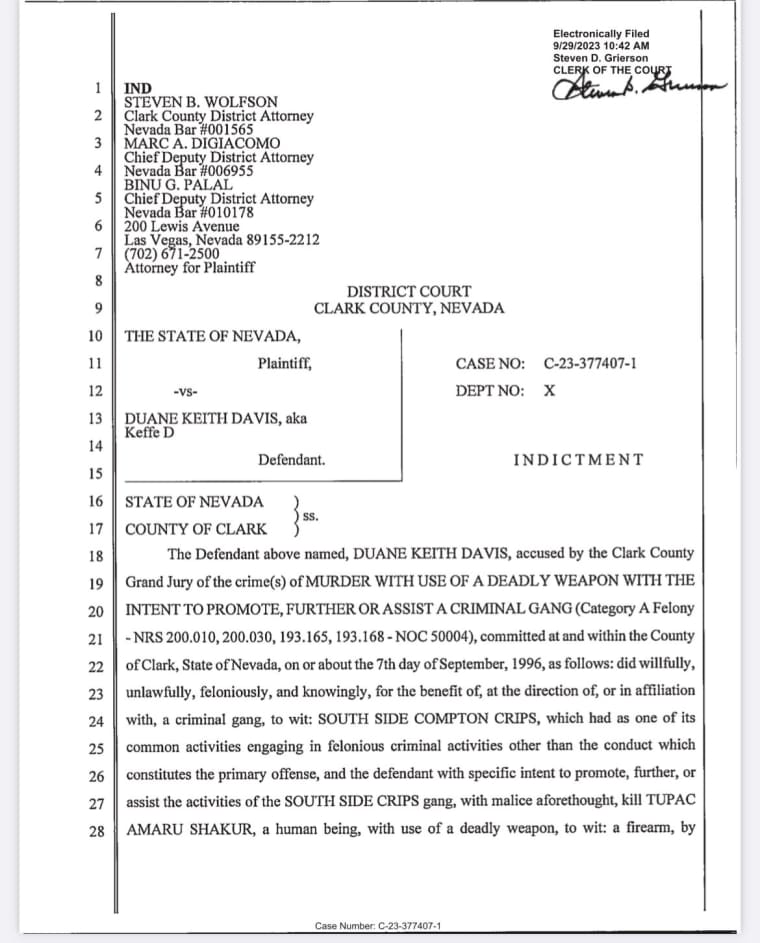

So who shot Tupac?
The story detailed above has remained mostly consistent for the past 20 years, though the identities of the white Cadillac’s occupants have been the subjects of endless speculation. In Friday’s press conference, the LVMPD corroborated the consensus that the four men in the car were Davis, Anderson, Terrence Brown, and Deandrae Smith. There’s little debate that Davis sat in the passenger seat the night of the shooting, or that Terrence Brown was the driver. But Anderson and Smith’s positioning in the back seat is less obvious. The cops now place Anderson on the passenger’s side and Smith on the driver’s side, which would mean Anderson would have had to shoot across Smith’s body to hit the BMW as they pulled up on its right side.
This seating chart matches the one laid out in Davis’ first interview about the shooting back in 2009. During his interrogation, Kading asked him to clarify this exact issue, asking, “So Orlando [Anderson] shot across Dre [Smith]?”
“He leaned over, and Orlando rolled down the window, and popped him,” Davis is quoted as saying in response. “If they would have drove on my side, I would have popped them. But they was on the other side.” It’s not entirely clear who “he” is in this statement, but it could (and has) been taken to mean that Smith leaned over to make room so that Anderson could have a clearer shot.
True or not, this chain of events doesn’t make much logical sense: If Davis had passed the gun off because the BMW had been on the opposite side of the Cadillac from him, giving it to Smith on the driver’s side would have been the obvious move. The idea that Smith, not Anderson, was Tupac’s killer is perhaps the most reasonable of the many alternate theories surrounding the rapper’s death — there are still many who believe that Shakur is alive and well and living in Cuba.
Davis has altered his story slightly since the first time he told it on record. For the past five years, he’s refused to restate that it was Anderson who killed Tupac. “Gonna keep it for the code of the streets,” he said, when asked point blank in Death Row Chronicles who shot Shakur. “It just came from the back seat, bro.” (He also claimed in his memoir that ‘Pac had started to pull a gun first and then exchanged fire when Anderson or Smith started shooting. “I don’t know why the Vegas police didn’t check Tupac’s hands for powder burns to see if he was shooting because the car we were in was shot the fuck up,” he wrote.)
Neither of the LVMPD officers who spoke at the September 29 press conference made a definitive statement about whether they believed Smith or Anderson had fired the shots that killed Tupac, and Davis’ indictment uses extremely conditional language when discussing the actual act of shooting. Per Clark County Chief Deputy District Attorney Marc DiGiacomo, Davis “did provide said firearm to Deandrae Smith aka ‘Big Dre’ and/or Orlando Anderson aka ‘Baby Lane’ with the intent that said co-conspirators commit said crime.”
What happened to the other men in the white Cadillac?
Orlando Anderson was killed in a gunfight outside a Compton car wash less than nine months after Shakur’s death. Deandrae Smith died of natural causes in 2004. And Terrence Brown was shot dead at a Compton medical marijuana dispensary called in 2015. Keefe D is the only member of the alleged murder party still alive today. Darnell Brimm, another South Side Crip who was previously suspected of being in the car, was sentenced in 2019 to 10 years in prison after pleading guilty to unrelated charges of conspiracy to distribute cocaine and crack.
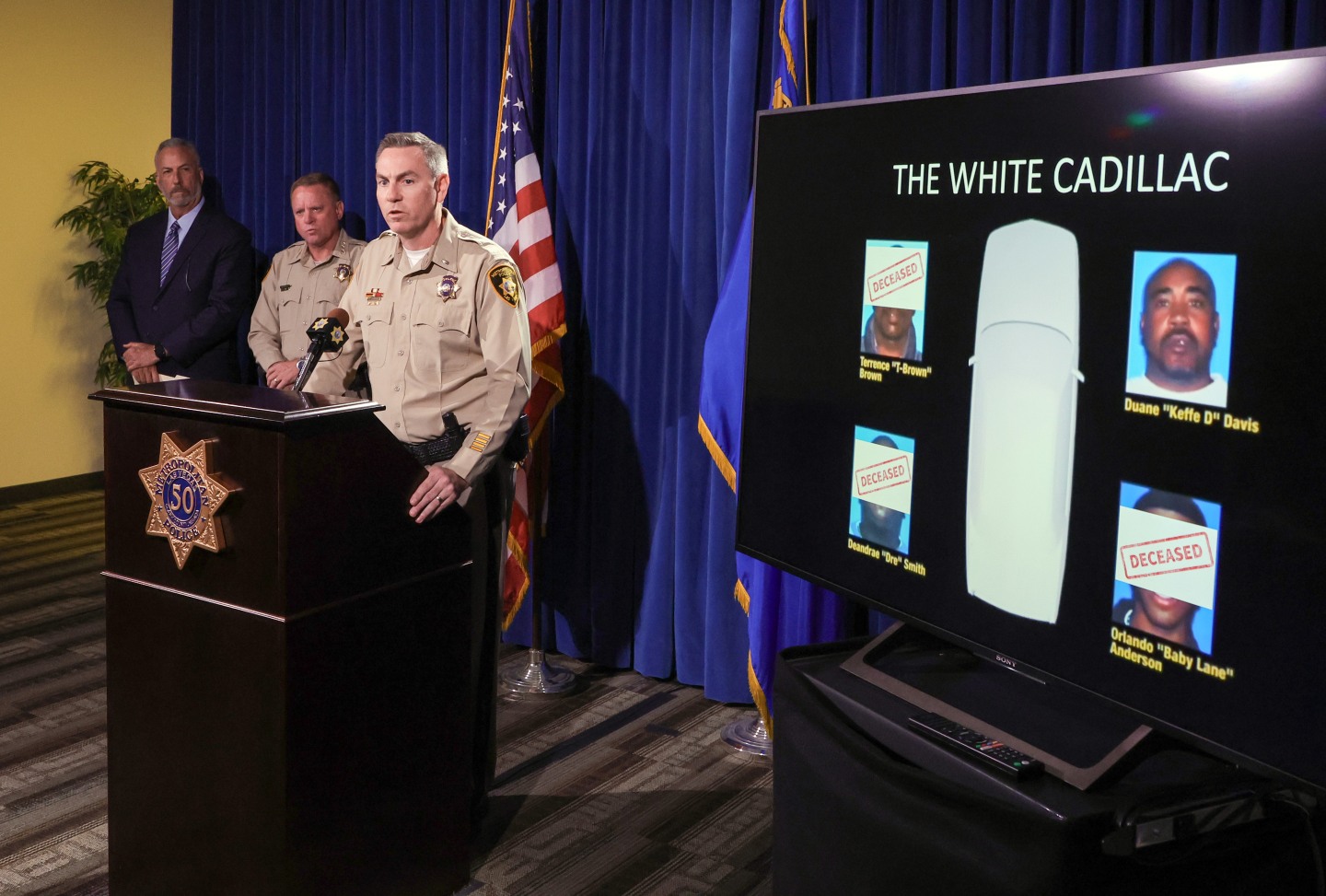 From left: Clark County District Attorney Steve Wolfson, Clark County Sheriff Kevin McMahill, and Las Vegas Metropolitan Police Department Lt. Jason Johansson at the Friday, September 29 press conference announcing Keefe D’s arrest. Photo by Ethan Miller/Getty Images.
From left: Clark County District Attorney Steve Wolfson, Clark County Sheriff Kevin McMahill, and Las Vegas Metropolitan Police Department Lt. Jason Johansson at the Friday, September 29 press conference announcing Keefe D’s arrest. Photo by Ethan Miller/Getty Images.
Why was no one arrested in connection with Tupac’s murder for 27 years?
LVMPD officers have stuck to the same script for the past quarter century when pressed on their failure to solve Tupac’s murder case: “Tupac got the same treatment as any other homicide here,” Sergeant Kevin Manning told Chuck Phillips for the L.A. Times in 2002. “But you know what? We can’t do it alone. We rely on cooperative citizens to step forward and help us solve crimes. And in Tupac’s case, we got no cooperation whatsoever.”
Knight, already a convicted felon, was described as especially uncooperative. According to his account, though, it was the cops who refused to help him in his moment of need. When he tried to tell an officer on the scene that he’d been shot in the head, he claimed the cop had responded by pointing his gun at him and saying, “If you don’t get down on your knees right now, buddy, you’re going to get shot in the fucking head again.”
In 2014, a retired cop named Chris Carroll who was a first responder at the scene, stopping Shakur and Knight’s procession as they fled west on Flamingo Boulevard from the shooting, told Vegas Seven he’d tried to get ‘Pac to name the man who shot him before the rapper passed out on the street, surrounded by his associates and arriving paramedics. “He looked at me and he took a breath to get the words out, and he opened his mouth, and I thought I was actually going to get some cooperation,” Carroll recalled. “And then the words came out: ‘Fuck you.’ After that, he started gurgling and slipping out of consciousness.” No one else present at the time of Shakur’s final conscious moments has corroborated Carroll’s account. Tupac was sedated for surgery when he arrived at the hospital; he never woke up.
In February 1997, Tupac’s mother, Afeni Shakur, told Phillips she was already sick of the LVMPD’s endless excuses for inaction. “Let me put it this way,” she said. “When my son was lying in the hospital in a medically induced coma, the Las Vegas police went on national television telling everybody that he was not cooperating with their investigation. It was clear to me from Day 1 that the Las Vegas police never had any interest in solving the case of my son’s murder.” (By that point in time, the department claimed to have narrowed their list of suspects in the case to three men but said they’d likely never be able to make an arrest without a witness coming forward.)
Indeed, Phillips’s Times investigation found several costly mistakes the LVMPD committed on the night of September 7, 1996 and afterwards that made it much more difficult for them to track down Tupac’s killer. These include discounting the attack at the MGM Grand as linked to the shooting, failing to follow up with Tupac’s entourage, and disregarding a potential lead on a white Cadillac that fit the description of the one driven to the murder that night.
Anderson was only interviewed by police about the events of September 7 once, after the LAPD swept the houses of dozens of alleged Crips in Compton, bringing them in on gang violence accusations in the hopes of coming up with something that would aid the Las Vegas police in finding Shakur’s killer. Their circumstantial evidence didn’t stick, however, and he was quickly released from jail. And, according to Phillips, LVMPD officers largely steered clear of exchanging notes with the Compton cops, worried they might be too close to the gangs and leak information that could hinder the case. Regardless of the reason, the department never interviewed Anderson.
“How is a cop from Vegas supposed to go out to Compton and get a powerful street gang to cooperate in a murder probe?” Jared Lewis, a Modesto, California detective who frequently dealt with gangs during his time on the force, asked the Times. “Gang homicide investigations are very complex. This was no easy case to solve, by any stretch of the imagination. I can understand why it ended up the way it has.”
 From left: Clark County District Attorney Steve Wolfson, Clark County Sheriff Kevin McMahill, and Las Vegas Metropolitan Police Department Lt. Jason Johansson at the Friday, September 29 press conference announcing Keefe D’s arrest. Photo by Ethan Miller/Getty Images.
From left: Clark County District Attorney Steve Wolfson, Clark County Sheriff Kevin McMahill, and Las Vegas Metropolitan Police Department Lt. Jason Johansson at the Friday, September 29 press conference announcing Keefe D’s arrest. Photo by Ethan Miller/Getty Images.
So why has Davis been arrested now?
It’s not entirely clear why the LVMPD waited until this year to arrest Davis. His 2009 interview with the LAPD, at least, fell under the terms of a proffer — an agreement informally dubbed “Queen for a Day,” in which information is exchanged for limited immunity. Whatever protections those cops offered him, however, were off the table by 2018, when he began publicly confessing to his role in Tupac’s killing.
“Mr. Davis’s own words reinvigorated our case in 2018,” LVMPD Sheriff Kevin McMahill said in the department’s press conference last week. “Specifically, Duane Davis’s own admissions to his involvement in this homicide investigation that he provided to numerous different media outlets,” Lieutenant Johansson added later.
“In our section, we knew at this time that this was likely our last time to take a run at this case, to successfully solve this case and bring forth a criminal charge,” Johansson continued. He went on to describe how the case was then assigned to Detective Cliff Mogg, who worked through the evidence over the last five years with a “systematic investigative plan,” collaborating with the Clark County District Attorney’s Office to build what they believe to be an airtight case against Davis.
The reopened investigation eventually led to the search warrant that was executed in July, producing evidence that was shown to the grand jury that ultimately indicted Davis. The warrant was approved by Clark County Judge Jacqueline Bluth, who agreed to seal Mogg’s affidavit detailing probable cause for the search, thereby compelling the public to take at face value the LVMPD’s explanation for reopening the 27-year-old cold case.
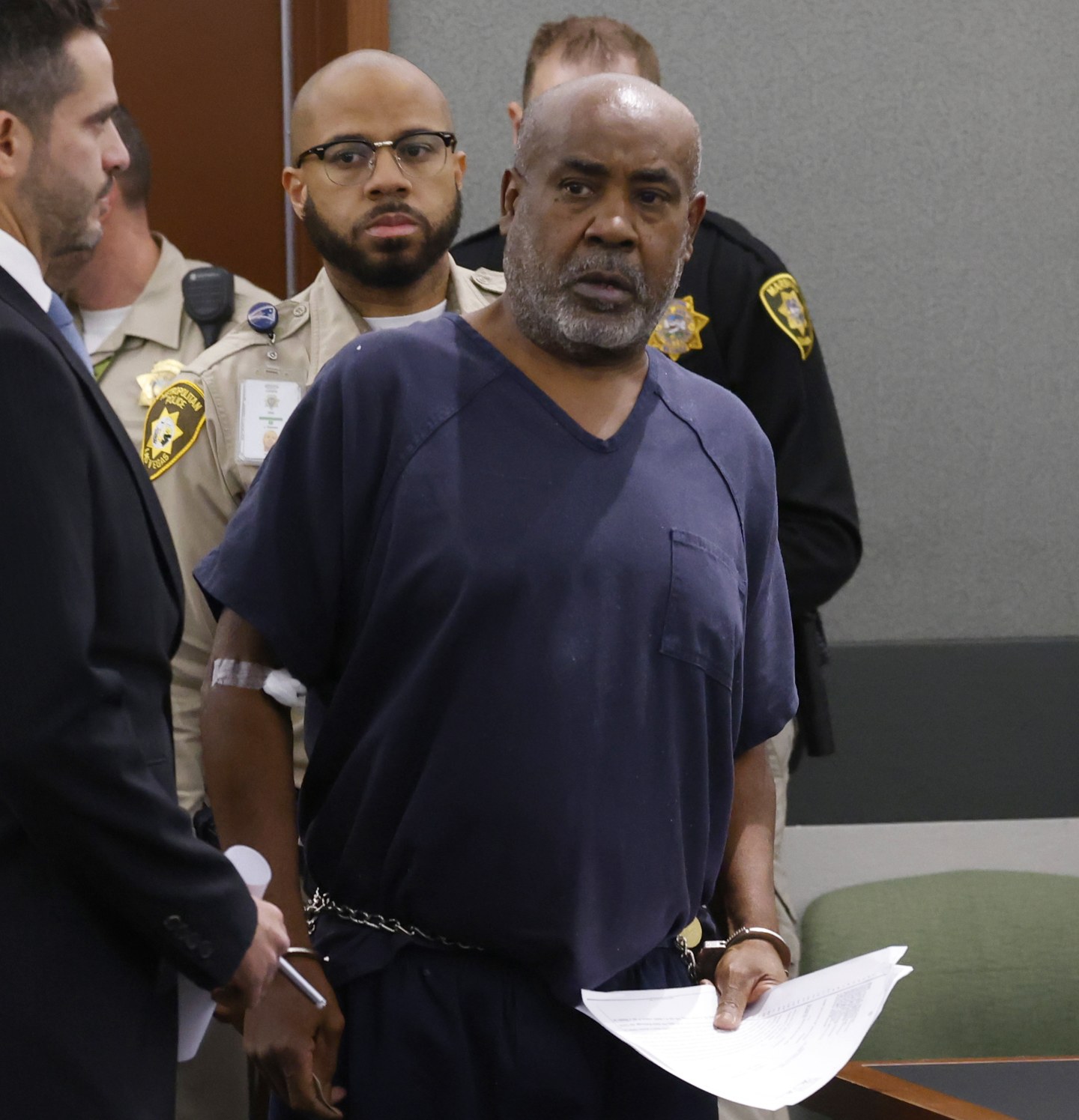 Duane Davis appears in court at the Regional Justice Center, on October 4, 2023 in Las Vegas, Nevada. Photo by Bizuayehu Tesfay via Pool/Getty Images.
Duane Davis appears in court at the Regional Justice Center, on October 4, 2023 in Las Vegas, Nevada. Photo by Bizuayehu Tesfay via Pool/Getty Images.
What happens next?
Davis is currently being held without bond at the Clark County Detention Center. His initial arraignment on October 4 was rescheduled to October 19, 2023 — Clark County District Judge Tara Jones granted him the continuance due to his attorney’s inability to make it to his first court appearance.
A person can be convicted of murder in the state of Nevada simply for assisting in the crime. If Davis is dealt a first-degree murder conviction, he could face between 50 years and life in prison, or the death penalty. (Nevada is one of 27 states where capital punishment is still permitted. There are currently 64 Nevada death row inmates, but no state-sanctioned executions have been carried out there since 2006.) Either way, the 60-year-old cancer survivor would likely be incarcerated for the rest of his life.
